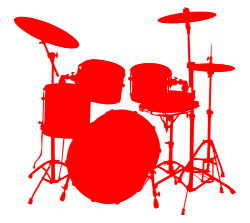Shuffle drum beats are frequently used in most types of contemporary music. The shuffle drum pattern differs from others like rock because it’s based on a triplet subdivision. Other drum beats are based on an 8th note or 16th note subdivision. When you play a shuffle rhythm you play the first and last notes of a triplet.
4 Basic Types Of Shuffles
1. Basic Shuffle. For this shuffle we’re going to play a basic rock beat, but instead of playing 8th notes with our right hand we’re going to play the shuffle rhythm.

I think of that primarily as a country shuffle. I’m starting with this one as it’s the easiest one to play. Notice we have a bass drum on 1 and 3. A good example of this is “Your Cheatin’ Heart by Hank Williams. I think technically he may be playing a swing beat with his right hand on this. But if you listen and play along you’ll get the idea. Listen to the way your bass drum fits with the bass player. He’s playing on 1 and 3 so it works well to play your bass drum on 1 and 3 as well.
2. 4 On The Floor Shuffle. This is similar to the last shuffle but you play your bass drum on all 4 beats.

Try playing this beat along with Kansas City by Wilbert Harrison. This has a very straight-ahead feel to it. Another song with a similar but slightly different feel is “Pride And Joy” by Stevie Ray Vaughn. The bass player on these type of tunes plays a walking bass line which is basically quarter notes. So if you play quarter notes on your bass drum this really fits with what he’s playing.
3. Broken Shuffle. This type of shuffle is more syncopated or off-beat. Instead of playing the bass drum on just 1 and 3 or all four beats it plays syncopated patterns that tend to follow the bass guitar and/or the rhythm guitar.

The first example of this type of shuffle is Revolution by The Beatles. Take a listen to that first.
The next broken shuffle uses quarter notes on the high hat rather than a shuffle rhythm. You can always play quarter notes rather than a shuffle rhythm with any type of shuffle beat as long as you retain the overall feel. This provides a nice variation. It also works well for faster tempos when it might be hard to keep up playing a shuffle rhythm with your right hand. It’s less busy and provides a more open sound, which in some cases actually sounds much better.

A great example of this type of beat is “Your Mamma Don’t Dance” by Loggins And Messina. This song actually starts with a half-time shuffle, which we’ll talk about in the next example. It then goes into a broken shuffle beat similar to the example I just demonstrated. Listen how the beat fits in with what the rest of the band is playing.
4. Half-time shuffle. With this type of shuffle the whole thing is cut in half. You play a bass drum on count one, and a snare drum on count 3.

I mentioned earlier on example of a song using this kind of beat- “Your Mamma Don’t’ Dance”. Although The drummer does vary from playing the bass drum on count one, the beginning beat is still a half-time shuffle.
The second example is “Rosanna’ by Toto. The beat played on that song is quite complicated and busy. But at its’ heart, it is actually a half-time shuffle. Listen how the bass drum and snare follow the bass player on this track.
